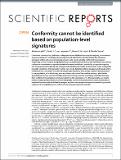Files in this item
Conformity cannot be identified based on population-level signatures
Item metadata
| dc.contributor.author | Acerbi, Alberto | |
| dc.contributor.author | van Leeuwen, Eduard Johannes Cornelis | |
| dc.contributor.author | Haun, Daniel | |
| dc.contributor.author | Tennie, Claudio | |
| dc.date.accessioned | 2016-11-14T14:30:14Z | |
| dc.date.available | 2016-11-14T14:30:14Z | |
| dc.date.issued | 2016-10-31 | |
| dc.identifier | 247649615 | |
| dc.identifier | 6dc6a01a-826c-402e-9ebd-79ada18b3cf0 | |
| dc.identifier | 84993983961 | |
| dc.identifier | 000386562000001 | |
| dc.identifier.citation | Acerbi , A , van Leeuwen , E J C , Haun , D & Tennie , C 2016 , ' Conformity cannot be identified based on population-level signatures ' , Scientific Reports , vol. 6 , 36068 . https://doi.org/10.1038/srep36068 | en |
| dc.identifier.issn | 2045-2322 | |
| dc.identifier.uri | https://hdl.handle.net/10023/9818 | |
| dc.description | The Netherlands Organisation for Scientific Research (NWO VIDI-grant 016.144312) supports the research of Alberto Acerbi. Claudio Tennie would like to thank the Economic and Social Research Council for financial support (ES/K008625/1). | en |
| dc.description.abstract | Conformist transmission, defined as a disproportionate likelihood to copy the majority, is considered a potent mechanism underlying the emergence and stabilization of cultural diversity. However, ambiguity within and across disciplines remains as to how to identify conformist transmission empirically. In most studies, a population level outcome has been taken as the benchmark to evidence conformist transmission: a sigmoidal relation between individuals’ probability to copy the majority and the proportional majority size. Using an individual-based model, we show that, under ecologically plausible conditions, this sigmoidal relation can also be detected without equipping individuals with a conformist bias. Situations in which individuals copy randomly from a fixed subset of demonstrators in the population, or in which they have a preference for one of the possible variants, yield similar sigmoidal patterns as a conformist bias would. Our findings warrant a revisiting of studies that base their conformist transmission conclusions solely on the sigmoidal curve. More generally, our results indicate that population level outcomes interpreted as conformist transmission could potentially be explained by other individual-level strategies, and that more empirical support is needed to prove the existence of an individual-level conformist bias in human and other animals. | |
| dc.format.extent | 516610 | |
| dc.language.iso | eng | |
| dc.relation.ispartof | Scientific Reports | en |
| dc.subject | BF Psychology | en |
| dc.subject | NDAS | en |
| dc.subject.lcc | BF | en |
| dc.title | Conformity cannot be identified based on population-level signatures | en |
| dc.type | Journal article | en |
| dc.contributor.institution | University of St Andrews. School of Psychology and Neuroscience | en |
| dc.identifier.doi | 10.1038/srep36068 | |
| dc.description.status | Peer reviewed | en |
This item appears in the following Collection(s)
Items in the St Andrews Research Repository are protected by copyright, with all rights reserved, unless otherwise indicated.

